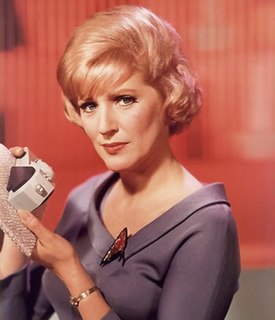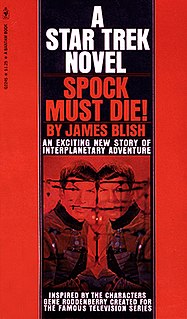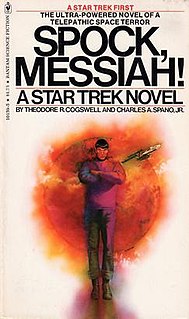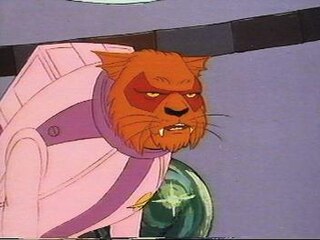Star Trek is an American science-fiction television series created by Gene Roddenberry that follows the adventures of the starship USS Enterprise (NCC-1701) and its crew. It later acquired the retronym of Star Trek: The Original Series (TOS) to distinguish the show within the media franchise that it began.

Star Trek: The Animated Series (TAS), originally airing as Star Trek and as The Animated Adventures of Gene Roddenberry's Star Trek, is an American animated science fiction television series created by Gene Roddenberry. It originally aired Saturday mornings from September 8, 1973, to October 12, 1974, on NBC, spanning 22 episodes over two seasons. The second series in the Star Trek franchise, it features the same characters as Star Trek: The Original Series. Set in the 23rd century, when Earth is part of a United Federation of Planets, it follows the adventures of the Starfleet vessel USS Enterprise as it explores the Milky Way galaxy.

Nyota Uhura is a fictional character in the Star Trek franchise. In the original TV series, the character was portrayed by Nichelle Nichols who later reprised the role for the first six Star Trek feature films. A younger Uhura will be portrayed by Celia Rose Gooding in the 2022 prequel series Star Trek: Strange New Worlds. Additionally, an alternate timeline version of Uhura has been portrayed by actress Zoe Saldana in the feature films Star Trek (2009), Star Trek Into Darkness (2013), and Star Trek Beyond (2016).

Hikaru Kato Sulu is a fictional character in the Star Trek media franchise. He was portrayed by George Takei in the original Star Trek series. Sulu also appears in the animated Star Trek series, the first six Star Trek movies, one episode of Star Trek: Voyager, and in numerous books, comics, and video games.
"The City on the Edge of Forever" is the twenty-eighth and penultimate episode of the first season of the American science fiction television series Star Trek. Written by Harlan Ellison, contributors and/or editors to the script included Steven W. Carabatsos, D. C. Fontana and Gene L. Coon. Gene Roddenberry made the final re-write. The episode was directed by Joseph Pevney and first aired on NBC on April 6, 1967.

"Where No Man Has Gone Before" is the third episode of the first season of the American science fiction television series, Star Trek. Written by Samuel A. Peeples and directed by James Goldstone, it first aired on September 22, 1966.

Christine Chapel is a fictional character who appears in all three seasons of the American science fiction television series Star Trek: The Original Series, as well as Star Trek: The Animated Series and the films Star Trek: The Motion Picture and Star Trek IV: The Voyage Home. Portrayed by Majel Barrett, she was the ship's nurse on board the Starfleet starship USS Enterprise. A younger version of Chapel is to appear in the 2022 series Star Trek: Strange New Worlds, portrayed by Jess Bush.
"The Man Trap" is the first episode of season one of the American science fiction television series Star Trek. Written by George Clayton Johnson and directed by Marc Daniels, it featured design work by Wah Chang and first aired in the United States on September 8, 1966.

"The Naked Time" is the fourth episode of the first season of the American science fiction television series Star Trek. Written by John D. F. Black and directed by Marc Daniels, it first aired on September 29, 1966.

Dorothy Catherine Fontana was an American television script writer and story editor, best known for her work on the original Star Trek franchise and several Western television series.
The Star Trek franchise has produced a large number of novels, comic books, video games, and other materials, which are generally considered non-canon.

Star Trek: The Motion Picture. A Novel is a 1979 novelization of the film Star Trek: The Motion Picture, which was released in the same year. It is especially notable for being the only Star Trek novel to be written by Gene Roddenberry, who created the franchise. It was also the first Star Trek novel published by Pocket Books, beginning a prolific relationship with the franchise that continues as of 2021. At the time the book was published, however, Bantam Books held the rights to publish original Star Trek-based fiction; Pocket Books wouldn't publish its first original Trek novel until 1981.

Spock Must Die! is an American science fiction novel written by James Blish, published February 1970 by Bantam Books. It was the first original novel based on the Star Trek television series intended for adult readers. It was preceded by a tie-in comic book line published by Gold Key and the novel Mission to Horatius by Mack Reynolds, all intended for younger readers.

Spock, Messiah! is the second original novel based on television series Star Trek intended for adult readers, written by Theodore R. Cogswell and Charles A. Spano, Jr. It was preceded by Spock Must Die! (1970), and Mission to Horatius (1968). However, Mission was intended for young readers.
"The Pirates of Orion" is the second season premiere episode of the American animated science fiction television series Star Trek: The Animated Series, the 17th episode overall. It first aired on NBC on September 7, 1974. It was directed by Bill Reed, and written by Howard Weinstein. The episode was Weinstein's first professional sale at the age of 19, making him, as of 2018, the youngest writer of any Star Trek TV episode.

"The Slaver Weapon" is the fourteenth episode of the first season of the American animated science fiction television series Star Trek: The Animated Series. It first aired on NBC on December 8, 1973, and was written by Larry Niven. It was based on his original short story "The Soft Weapon". This episode was expanded to become the first half of a full-length novel by science-fiction author Alan Dean Foster as Star Trek Log Ten.
Star Trek is an American science fiction media franchise created by Gene Roddenberry, which began with the eponymous 1960s series and quickly became a worldwide pop-culture phenomenon. The franchise has been expanded into various films, television series, video games, novels, and comic books. With an estimated $10.6 billion in revenue, Star Trek is one of the most recognizable and highest-grossing media franchises of all time.

Killing Time is a Star Trek: The Original Series novel written by Della Van Hise and published by Pocket Books in 1985. The original manuscript had Kirk/Spock slash fiction elements, and these were requested to be removed by Paramount. However, they were not removed, and 250,000 copies were printed. These romantic undertones between Spock and James T. Kirk were brought to the attention of the office of the creator of Star Trek, Gene Roddenberry, who made Pocket Books recall the first edition. This edition subsequently became a collector's item, with more than fifty changes made to a revised version.

Star Trek: The God Thing is an unproduced film script written by Star Trek series creator Gene Roddenberry. Following the success of Star Trek in broadcast syndication during the early 1970s, Paramount Pictures sought to produce a feature film based on the property. The film's plot follows the Enterprise crew after the events of The Original Series: when an alien entity declares itself God and begins travel to Earth, Admiral James T. Kirk reunites the crew, who send it back to its own dimension. Roddenberry completed the story on June 30, 1976, but Paramount rejected the script for reasons Roddenberry attributed to the religious views of company executives. Story elements were used in Star Trek V: The Final Frontier.













